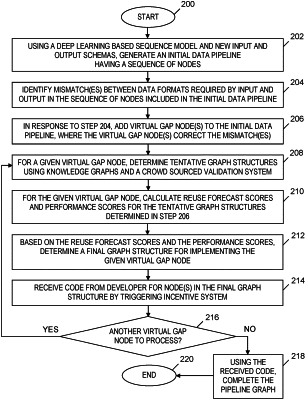| CPC G06F 16/9024 (2019.01) [G06F 11/3684 (2013.01); G06F 11/3692 (2013.01); G06F 18/217 (2023.01); G06N 3/08 (2013.01); G06N 5/022 (2013.01)] | 17 Claims |

|
1. A computer-implemented method comprising:
using a deep learning based sequence model, generating, by one or more processors, an initial data pipeline having a sequence of nodes;
identifying, by the one or more processors, one or more mismatches, a given mismatch included in the one or more mismatches indicates that a first data format specified by an output schema of a first node included in two consecutive nodes in the sequence of nodes does not match a second data format specified by an input schema of a second node included in the two consecutive nodes, and the second node following the first node in the sequence of nodes;
in response to the identifying the one or more mismatches, adding to the initial data pipeline, by the one or more processors, one or more virtual gap nodes which correct the one or more mismatches;
for a given virtual gap node included in the one or more virtual gap nodes, determining, by the one or more processors, tentative graph structures using knowledge graphs and a crowd sourced validation system and calculating, by the one or more processors, reuse forecast scores and performance scores for the tentative graph structures;
based on the reuse forecast scores and the performance scores, determining, by the one or more processors, a final graph structure for implementing the given virtual gap node; and
training, by the one or more processors, the deep learning based sequence model, wherein the generating the initial data pipeline includes generating a sequence of transformers using the trained deep learning based sequence model, and wherein the adding the one or more virtual gap nodes includes adding one or more new virtual transformers.
|